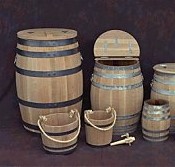![]() The privilege of teaching their art
The privilege of teaching their art
 Early Irish literature is almost completely silent on the question of whether the Irish people, down through the ages, danced at all. The two words in the Irish language for dancing, rince and damhsa, are both borrowed and are not native. We have plenty of evidence, however, that dancing-masters were very numerous in this country during recent centuries. I have been told [1961] by an old man that he was at a fair in Sneem, Co. Kerry, in his young days where he saw two dancing-masters perform alternately on top of a soaped barrel, vying for the privilege of teaching their art to the youth of the parish during the following year. These itinerant teachers were very popular, and from them the people learned how to dance. My friend, FionŠn Mac Coluim, has told me that he heard how a dancing-master died in Liscarroll in Co. Limerick. He was waked there for a few nights to the accompaniment of much fun and music, and when it was over, the people of a neighbouring parish took the body to be waked in a similar way for two further nights in their own district. Such was the estimation in which that dancing-master, for one, was held! It is even said that the corpse was sometimes taken out to dance! The usual dances performed at wakes were single or double reels, jigs and hornpipes, as well as sets. In the rare cases where neither a piper nor a fiddler was available, a mouth-organ or lilting sufficed.
Early Irish literature is almost completely silent on the question of whether the Irish people, down through the ages, danced at all. The two words in the Irish language for dancing, rince and damhsa, are both borrowed and are not native. We have plenty of evidence, however, that dancing-masters were very numerous in this country during recent centuries. I have been told [1961] by an old man that he was at a fair in Sneem, Co. Kerry, in his young days where he saw two dancing-masters perform alternately on top of a soaped barrel, vying for the privilege of teaching their art to the youth of the parish during the following year. These itinerant teachers were very popular, and from them the people learned how to dance. My friend, FionŠn Mac Coluim, has told me that he heard how a dancing-master died in Liscarroll in Co. Limerick. He was waked there for a few nights to the accompaniment of much fun and music, and when it was over, the people of a neighbouring parish took the body to be waked in a similar way for two further nights in their own district. Such was the estimation in which that dancing-master, for one, was held! It is even said that the corpse was sometimes taken out to dance! The usual dances performed at wakes were single or double reels, jigs and hornpipes, as well as sets. In the rare cases where neither a piper nor a fiddler was available, a mouth-organ or lilting sufficed.
![]()